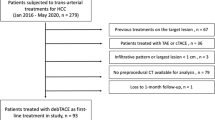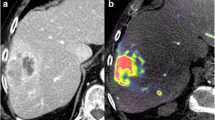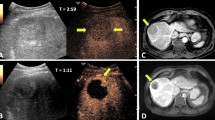Abstract
Objectives
In this study, pre-treatment target lesion vascularisation in either contrast-enhanced (CE) CT or MRI and post-treatment lipiodol deposition in native CT scans were compared in HCC patients who underwent their first cTACE treatment. We analysed the impact of stratification according to cTACE selectivity on these correlations.
Methods
Seventy-eight HCC patients who underwent their first cTACE procedure were retrospectively included. Pre-treatment tumour vascularisation in arterial contrast phase and post-treatment lipiodol deposition in native CT scans were evaluated using the qEASL (quantitative tumour enhancement) method. Correlations were analysed using scatter plots, the Pearson correlation coefficient (PCC) and linear regression analysis. Subgroup analysis was performed according to lobar, segmental and subsegmental execution of cTACE.
Results
Arterial tumour volumes in both baseline CE CT (R2 = 0.83) and CE MR (R2 = 0.82) highly correlated with lipiodol deposition after cTACE. The regression coefficient between lipiodol deposition and enhancing tumour volume was 1.39 for CT and 0.33 for MR respectively, resulting in a ratio of 4.24. After stratification according to selectivity of cTACE, the regression coefficient was 0.94 (R2 = 1) for lobar execution, 1.38 (R2 = 0.96) for segmental execution and 1.88 (R2 = 0.89) for subsegmental execution in the CE CT group.
Conclusions
Volumetric lipiodol deposition can be used as a reference to compare different imaging modalities in detecting vital tumour volumes. That approach proved CE MRI to be more sensitive than CE CT. Selectivity of cTACE significantly impacts the respective regression coefficients which allows for an innovative approach to the assessment of technical success after cTACE with a multitude of possible applications.
Key Points
• Lipiodol deposition after cTACE highly correlates with pre-treatment tumour vascularisation and can be used as a reference to compare different imaging modalities in detecting vital tumour volumes.
• Lipiodol deposition also correlates with the selectivity of cTACE and can therefore be used to quantify the technical success of the intervention.




Similar content being viewed by others
Abbreviations
- ASIR:
-
Adaptive statistical iterative reconstruction
- BCLC:
-
Barcelona Clinic Liver Cancer staging system
- CE:
-
Contrast-enhanced
- cTACE:
-
Conventional transarterial chemoembolisation
- ECOG:
-
Eastern Cooperative Oncology Group
- ETV:
-
Enhancing tumour volume
- HCC:
-
Hepatocellular carcinoma
- HKLC:
-
Hong Kong Liver Cancer staging system
- PCC:
-
Pearson correlation coefficient
- (q)EASL:
-
(quantitative) European Association for the Study of the Liver (quantitative tumour enhancement)
- RECIST:
-
Response Evaluation Criteria in Solid Tumors
- ROI:
-
Region of interest
- SEER:
-
Surveillance, Epidemiology, and End Results
- TTV:
-
Total tumour volume
References
Center MM, Jemal A (2011) International trends in liver cancer incidence rates. Cancer Epidemiol Biomarkers Prev 20:2362–2368
Torre LA, Bray F, Siegel RL, Ferlay J, Lortet-Tieulent J, Jemal A (2015) Global cancer statistics, 2012. CA Cancer J Clin 65:87–108
Forner A, Reig M, Bruix J (2018) Hepatocellular carcinoma. Lancet 391:1301–1314
Liver and Intrahepatic Bile Duct Cancer - Cancer Stat Facts. In: SEER. Available via https://seer.cancer.gov/statfacts/html/livibd.html. Accessed 4 Mar 2019
Llovet JM, Brú C, Bruix J (1999) Prognosis of hepatocellular carcinoma: the BCLC staging classification. Semin Liver Dis 19:329–338
Yau T, Tang VYF, Yao T-J, Fan S-T, Lo C-M, Poon RTP (2014) Development of Hong Kong Liver Cancer staging system with treatment stratification for patients with hepatocellular carcinoma. Gastroenterology 146:1691–1700.e3
Tacher V, Lin M, Duran R et al (2016) Comparison of existing response criteria in patients with hepatocellular carcinoma treated with transarterial chemoembolization using a 3D quantitative approach. Radiology 278:275–284
Chapiro J, Duran R, Lin M et al (2015) Identifying staging markers for hepatocellular carcinoma before transarterial chemoembolization: comparison of three-dimensional quantitative versus non-three-dimensional imaging markers. Radiology 275:438–447
Bonekamp S, Li Z, Geschwind JF et al (2013) Unresectable hepatocellular carcinoma: MR imaging after intraarterial therapy. Part I. Identification and validation of volumetric functional response criteria. Radiology 268:420–430
Kim BK, Kim SU, Kim M-J et al (2013) Number of target lesions for EASL and modified RECIST to predict survivals in hepatocellular carcinoma treated with chemoembolization. Clin Cancer Res 19:1503–1511
Lencioni R, Llovet JM (2010) Modified RECIST (mRECIST) assessment for hepatocellular carcinoma. Semin Liver Dis 30:52–60
Chapiro J, Geschwind JF (2014) Hepatocellular carcinoma: have we finally found the ultimate staging system for HCC? Nat Rev Gastroenterol Hepatol 11:334–336
Wang Z, Chen R, Duran R et al (2015) Intraprocedural 3D quantification of lipiodol deposition on cone-beam CT predicts tumor response after transarterial chemoembolization in patients with hepatocellular carcinoma. Cardiovasc Intervent Radiol 38:1548–1556
Fleckenstein FN, Schernthaner RE, Duran R et al (2016) 3D quantitative tumour burden analysis in patients with hepatocellular carcinoma before TACE: comparing single-lesion vs. multi-lesion imaging biomarkers as predictors of patient survival. Eur Radiol 26:3243–3252
Najmi Varzaneh F, Pandey A, Aliyari Ghasabeh M et al (2018) Prediction of post-TACE necrosis of hepatocellular carcinoma usingvolumetric enhancement on MRI and volumetric oil deposition on CT, with pathological correlation. Eur Radiol 28:3032–3040
Peng J, Kang S, Ning Z et al (2019) Residual convolutional neural network for predicting response of transarterial chemoembolization in hepatocellular carcinoma from CT imaging. Eur Radiol. https://doi.org/10.1007/s00330-019-06318-1
Chapiro J, Tacher V, Geschwind JF (2013) Intraarterial therapies for primary liver cancer: state of the art. Expert Rev Anticancer Ther 13:1157–1167
Ayuso C, Rimola J, Vilana R et al (2018) Diagnosis and staging of hepatocellular carcinoma (HCC): current guidelines. Eur J Radiol 101:72–81
Lin M, Pellerin O, Bhagat N et al (2012) Quantitative and volumetric European Association for the Study of the Liver and Response Evaluation Criteria in Solid Tumors measurements: feasibility of a semiautomated software method to assess tumor response after transcatheter arterial chemoembolization. J Vasc Interv Radiol 23:1629–1637
Vouche M, Kulik L, Atassi R et al (2013) Radiological-pathological analysis of WHO, RECIST, EASL, mRECIST and DWI: imaging analysis from a prospective randomized trial of Y90 ± sorafenib. Hepatology 58:1655–1666
Chapiro J, Wood LD, Lin M et al (2014) Radiologic-pathologic analysis of contrast-enhanced and diffusion-weighted MR imaging in patients with HCC after TACE: diagnostic accuracy of 3D quantitative image analysis. Radiology 273:746–758
Bonekamp S, Halappa VG, Geschwind JFH et al (2013) Unresectable hepatocellular carcinoma: MR imaging after intraarterial therapy. Part II. Response stratification using volumetric functional criteria after intraarterial therapy. Radiology 268:431–439
Chapiro J, Duran R, Lin M et al (2015) Early survival prediction after intra-arterial therapies: a 3D quantitative MRI assessment of tumour response after TACE or radioembolization of colorectal cancer metastases to the liver. Eur Radiol 25:1993–2003
Chapiro J, Lin M, Duran R, Schernthaner RE, Geschwind JF (2015) Assessing tumor response after loco-regional liver cancer therapies: the role of 3D MRI. Expert Rev Anticancer Ther 15:199–205
Ogura A, Miyai A, Maeda F, Hongoh T, Kikumoto R (2002) Comparison of contrast resolution between dynamic MRI and dynamic CT in liver scanning. Nihon Hoshasen Gijutsu Gakkai Zasshi 58:286–291
Funding
The authors state that this work has not received any funding.
Author information
Authors and Affiliations
Corresponding author
Ethics declarations
Guarantor
The scientific guarantor of this publication is Willie-Magnus Lüdemann.
Conflict of interest
The authors of this manuscript declare no relationships with any companies, whose products or services may be related to the subject matter of the article.
Statistics and biometry
One of the authors has significant statistical expertise.
Informed consent
Written informed consent was not required for this specific study because data were evaluated retrospectively. Written informed consent was obtained to use data for general scientific evaluation.
Ethical approval
Institutional Review Board approval was obtained.
Methodology
• retrospective
• case-control study/observational
• performed at one institution
Additional information
Publisher’s note
Springer Nature remains neutral with regard to jurisdictional claims in published maps and institutional affiliations.
Rights and permissions
About this article
Cite this article
Luedemann, W., Geisel, D., Gebauer, B. et al. Comparing HCC arterial tumour vascularisation on baseline imaging and after lipiodol cTACE: how do estimations of enhancing tumour volumes differ on contrast-enhanced MR and CT?. Eur Radiol 30, 1601–1608 (2020). https://doi.org/10.1007/s00330-019-06430-2
Received:
Revised:
Accepted:
Published:
Issue Date:
DOI: https://doi.org/10.1007/s00330-019-06430-2




